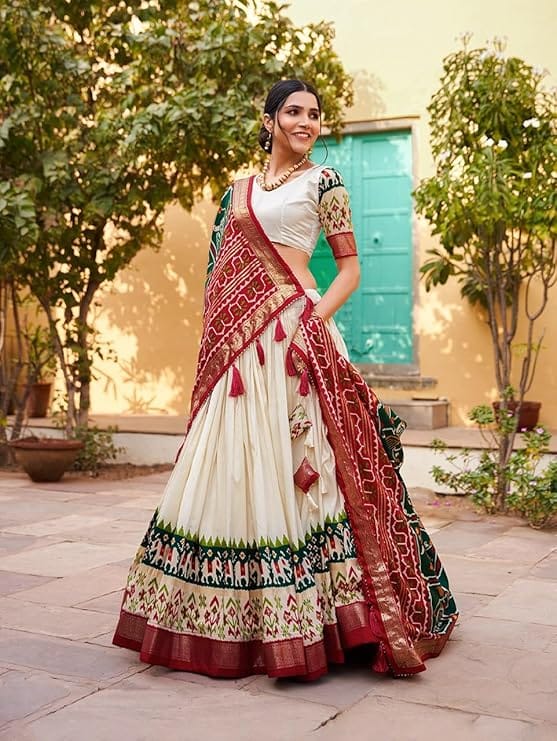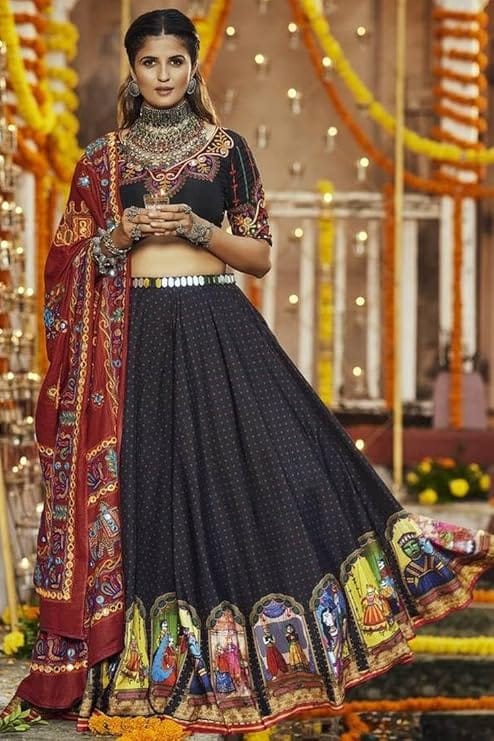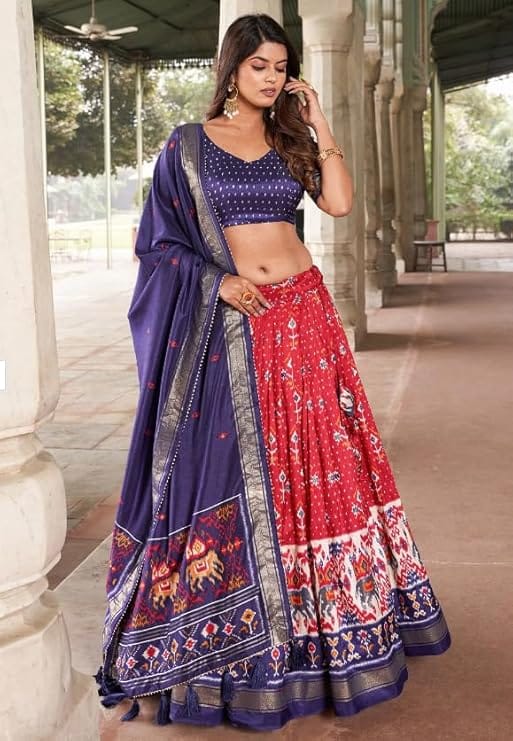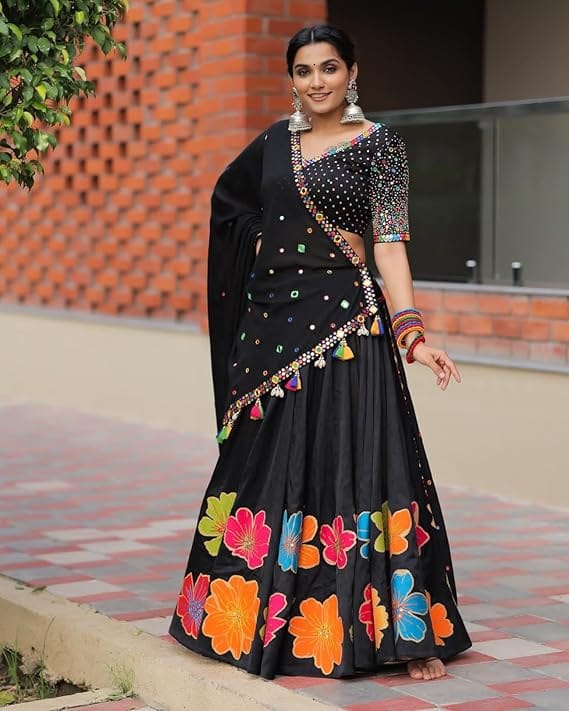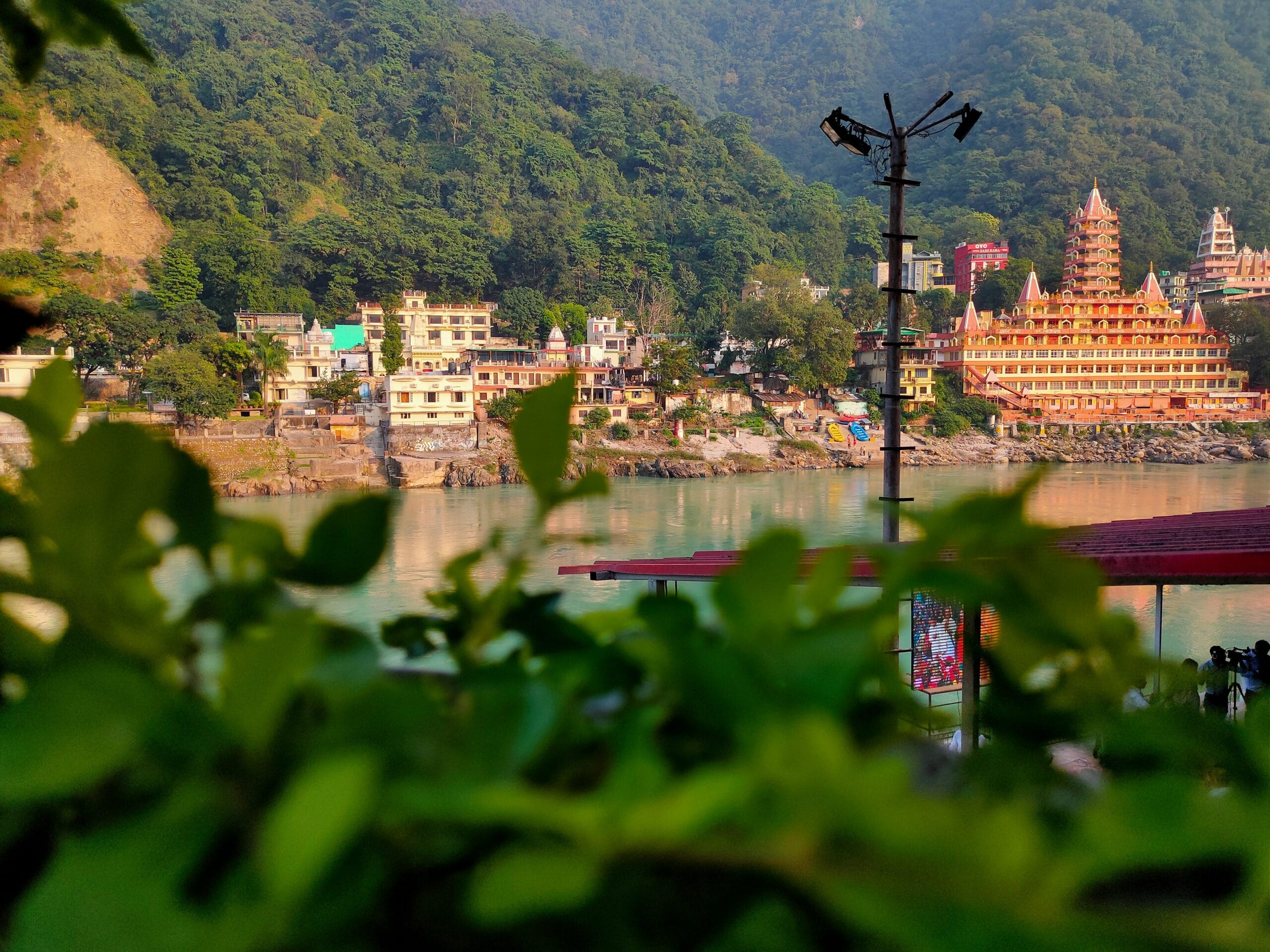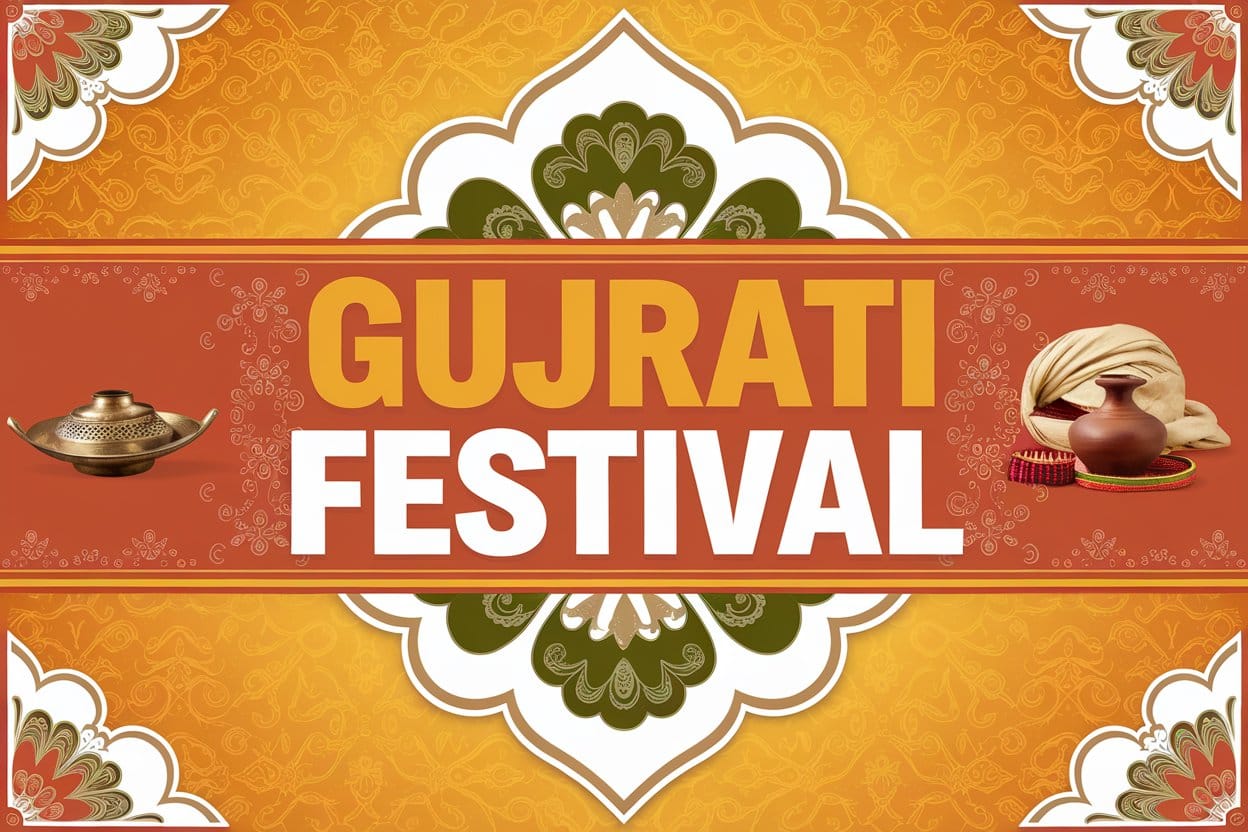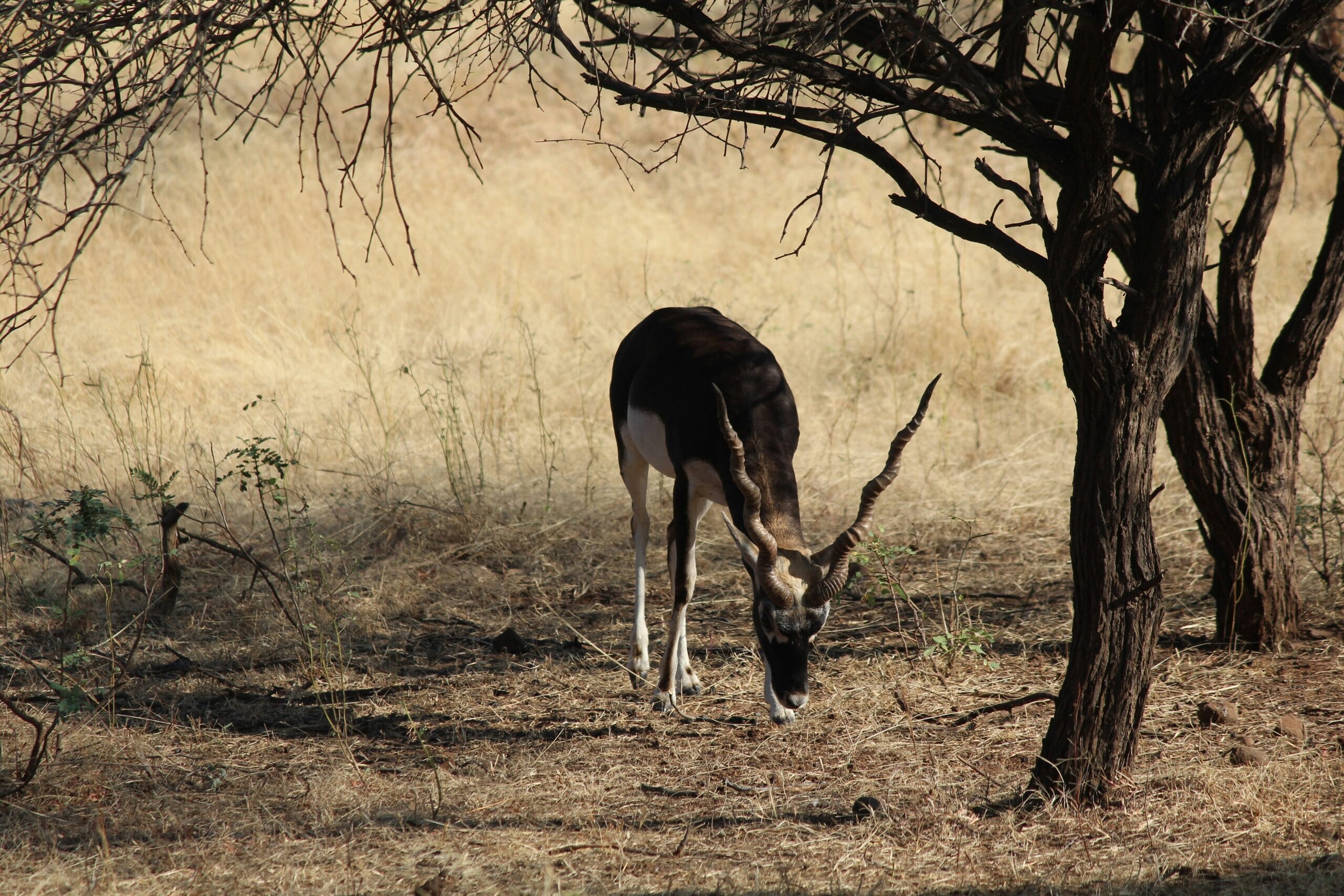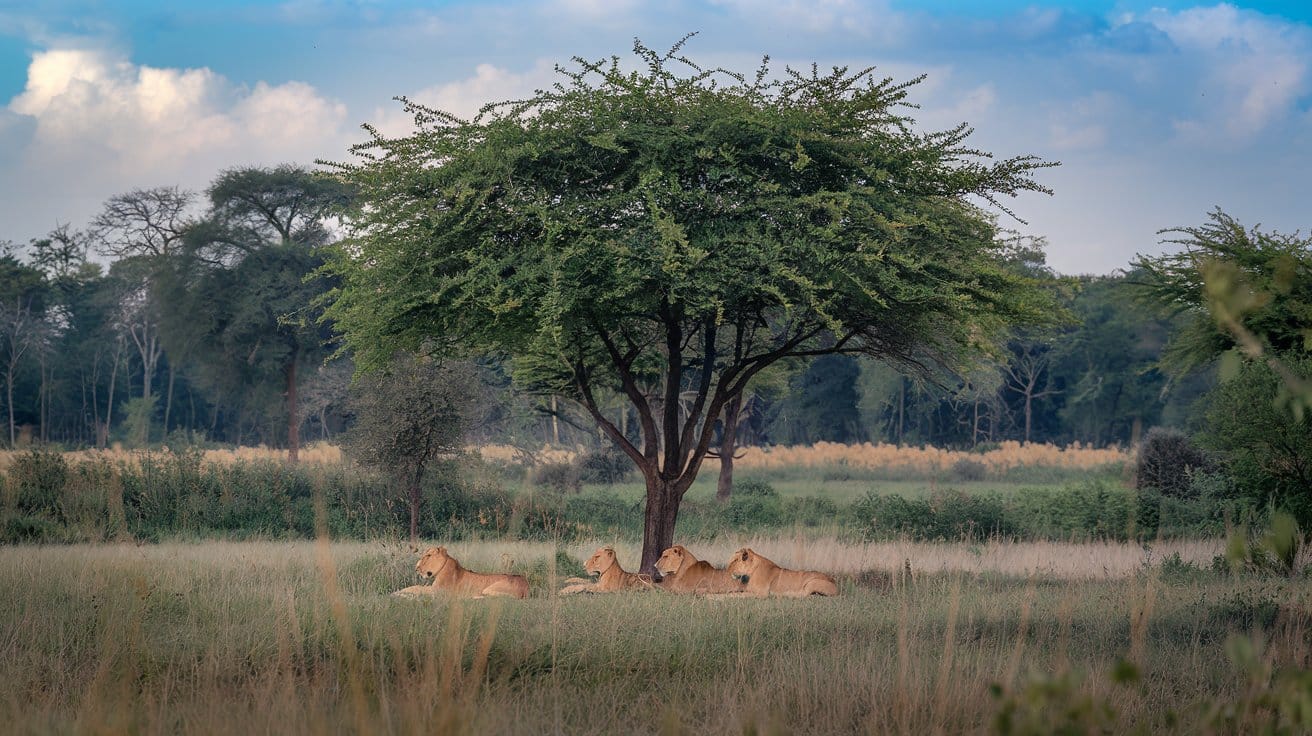Gujarati Festivals: A Celebration of Culture and Tradition
Gujarat, the land of vibrant colors, rich traditions, and warm hospitality, is known for its grand celebrations and cultural festivities. From the world-famous Navratri to the picturesque Rann Utsav, Gujarati festivals are a true reflection of the state’s rich heritage and deep-rooted traditions. These festivals bring together people from all walks of life, offering a glimpse into Gujarat’s joyful and lively spirit. Whether it’s the spiritual fervor of Janmashtami, the exhilarating kite-flying of Uttarayan, or the rustic charm of Tarnetar Fair, every festival in Gujarat has its own unique charm.
Navratri: The Grand Dance Festival
When it comes to Gujarati Festivals, Navratri stands out as one of the most vibrant and widely celebrated events in the state. This nine-night festival, dedicated to Goddess Durga, is a mesmerizing blend of devotion, dance, music, and cultural heritage. Unlike any other festival in India, Navratri in Gujarat transforms the entire state into a massive dance floor, where people of all ages come together to perform the traditional Garba and Dandiya Raas.
The beauty of Navratri lies in its grandeur and inclusivity. Cities like Ahmedabad, Vadodara, and Rajkot host some of the largest Navratri celebrations, attracting thousands of visitors from across the country and beyond. The rhythmic beats of the dhol, the colorful chaniya cholis and kediyus, and the energetic dance moves make this festival an unforgettable experience.
Beyond the dance and music, Navratri is also a time for spiritual reflection and fasting. Devotees observe special fasts, abstaining from grains and consuming sattvic food. Temples across Gujarat are adorned with lights and flowers, and grand aartis are performed in honor of Goddess Durga.
Navratri is not just a festival; it is an emotion for the people of Gujarat. It brings families and communities together, strengthens cultural bonds, and showcases the true essence of Gujarati Festivals. Whether you are a participant or a spectator, experiencing Navratri in Gujarat is a magical journey that leaves a lasting impression.
Rann Utsav: A Celebration in the White Desert
Among the many Gujarati Festivals, Rann Utsav holds a special place as a unique and breathtaking celebration of Gujarat’s rich culture, traditions, and natural beauty. Held in the vast and mesmerizing White Rann of Kutch, this festival transforms the barren salt desert into a vibrant hub of festivities, attracting visitors from all over the world.
Rann Utsav is a perfect blend of cultural extravaganza and adventure. The festival showcases the true essence of Gujarat through its folk music, traditional dance performances, handcrafted art, and local cuisine. Tourists can indulge in activities like camel rides, paramotoring, and hot air ballooning while soaking in the stunning views of the full moon over the endless white desert—a sight that remains etched in memory forever.
One of the most distinctive features of Rann Utsav is the beautifully crafted tent city, which offers a luxurious stay amidst the raw beauty of nature. Visitors can explore the nearby villages to witness the intricate handicrafts made by Kutch artisans, including embroidery, bandhani (tie-dye), and Rogan art. The festival is also a time to experience Gujarat’s rich heritage through performances of Garba, Bhavai, and Sufi music.
Rann Utsav is more than just a festival; it is an immersive experience that allows travelers to witness the magic of Gujarat’s culture and landscape. As one of the most famous Gujarati Festivals, it beautifully showcases the state’s love for art, tradition, and hospitality, making it a must-visit event for anyone looking to experience the heart of Gujarat.
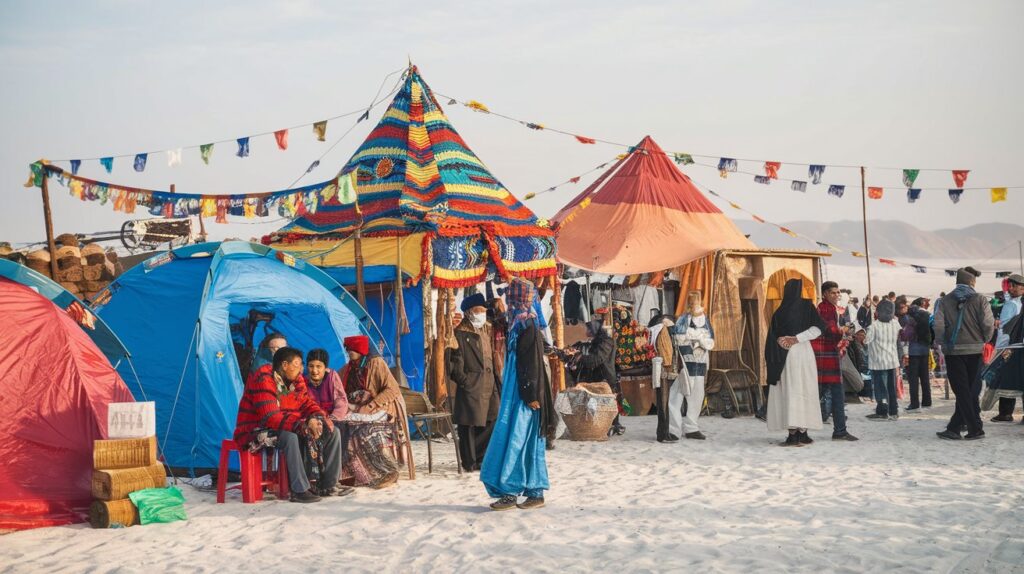
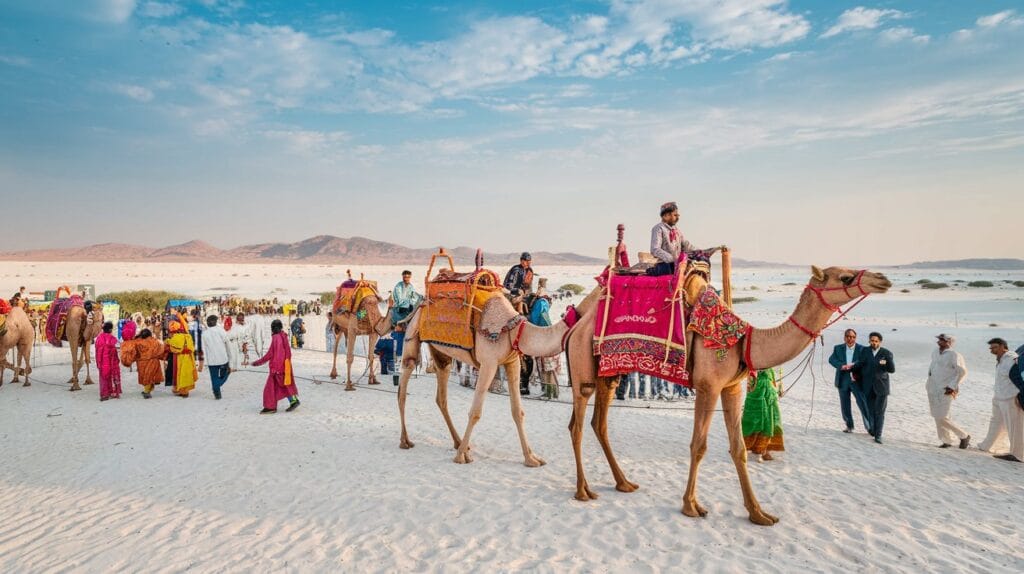
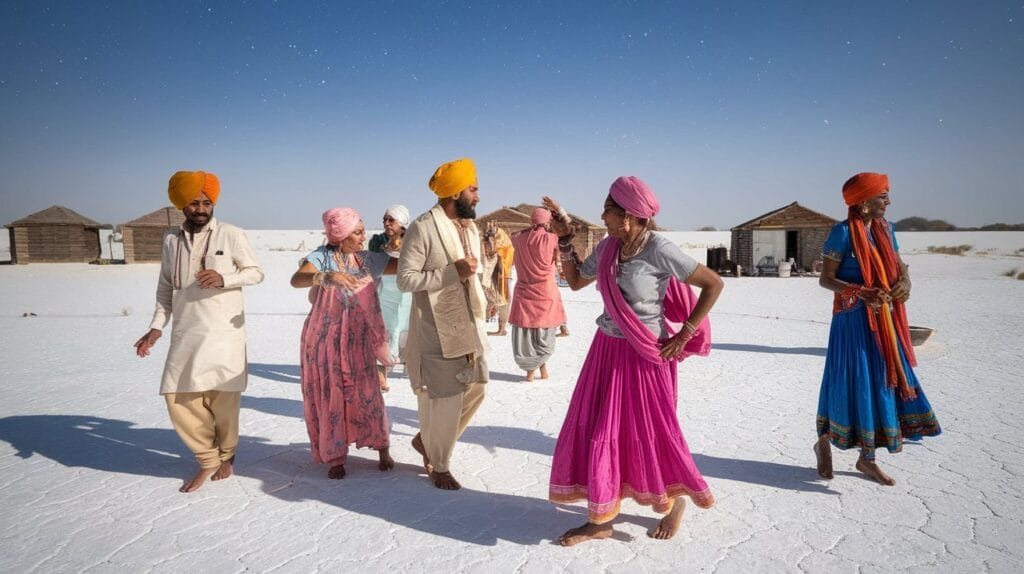
Uttarayan: The International Kite Festival
When talking about Gujarati Festivals, one cannot miss Uttarayan—the festival that paints the sky with countless colorful kites. Celebrated every year on January 14th, Uttarayan marks the transition of the sun into the northern hemisphere, symbolizing the arrival of longer days and the harvest season. This festival is more than just flying kites; it is a grand celebration of joy, competition, and togetherness.
Gujarat transforms into a kite lover’s paradise during Uttarayan, with cities like Ahmedabad, Surat, and Vadodara hosting massive kite-flying events. From dawn to dusk, people gather on rooftops, battling in friendly competitions to cut each other’s kites. The excitement in the air is contagious, as chants of “Kai po che!” (I have cut your kite!) echo across neighborhoods.
One of the highlights of Uttarayan is the International Kite Festival, held in Ahmedabad, where kite enthusiasts from across the world showcase their unique and artistic kites. From gigantic kites shaped like dragons to intricately designed ones representing different cultures, the sky becomes a stunning display of creativity and craftsmanship.
Uttarayan is incomplete without indulging in traditional Gujarati delicacies. People relish sweets like chikki (made of jaggery and peanuts) and feast on delicious dishes like undhiyu, a flavorful mixed vegetable dish prepared specially for the occasion. The festival beautifully blends celebration with culinary delights, making it a feast for both the eyes and the taste buds.
As one of the most exciting Gujarati Festivals, Uttarayan is a time of joy, unity, and endless fun. Whether you’re flying kites, enjoying the festive food, or simply soaking in the lively atmosphere, Uttarayan is an unforgettable experience that showcases the energetic spirit of Gujarat.



Modhera Dance Festival: A Cultural Extravaganza
Among the many vibrant Gujarati Festivals, the Modhera Dance Festival stands out as a mesmerizing celebration of art, history, and culture. Held annually at the stunning Modhera Sun Temple in Mehsana district, this festival brings classical dance, music, and heritage together in a breathtaking setting. Organized by the Gujarat Tourism Department, the event is a tribute to India’s rich performing arts and an opportunity to experience the architectural splendor of the 11th-century temple under the glow of illuminated lights.
The festival takes place in January, right after Uttarayan, and transforms the Modhera Sun Temple into an open-air stage where renowned dancers from across the country perform traditional Indian dance forms like Bharatanatyam, Kathak, Odissi, Kuchipudi, and more. The temple’s grand backdrop, with its intricately carved walls and sacred water tank (Surya Kund), adds an ethereal charm to the performances, making it an unforgettable experience.
What makes the Modhera Dance Festival special is its ability to transport visitors to an era where art and devotion were deeply intertwined. The festival is not just about dance but also about storytelling—every movement narrates tales from Indian mythology, folklore, and history. The ambiance, with the moonlit temple and the rhythmic beats of classical music, creates an atmosphere of spiritual and artistic bliss.
For culture enthusiasts, the Modhera Dance Festival is a must-visit among Gujarati Festivals. It offers a rare chance to witness India’s classical dance traditions in a heritage setting while immersing oneself in the timeless beauty of Gujarat’s artistic legacy. Whether you’re a lover of dance, history, or simply looking for a unique experience, this festival is a captivating journey into Gujarat’s rich cultural heritage.
Janmashtami: Celebrating Lord Krishna’s Birth
Among the many vibrant Gujarati Festivals, Janmashtami holds a special place in the hearts of devotees. Celebrated with immense devotion and grandeur, this festival marks the birth of Lord Krishna, one of the most revered deities in Hindu mythology. Gujarat, being home to Dwarka, the legendary kingdom of Krishna, witnesses some of the most magnificent Janmashtami celebrations in the country.
The festival usually falls in August, on the eighth day (Ashtami) of the Krishna Paksha in the Hindu month of Shravan. Devotees observe fasts, chant bhajans, and perform special prayers at temples dedicated to Krishna. The temples in Dwarka and Mathura come alive with elaborate decorations, devotional songs, and dramatic enactments (Ras Leela) of Krishna’s life. The Dwarkadhish Temple in Dwarka becomes the epicenter of celebrations, drawing thousands of pilgrims from across the nation.
One of the highlights of Janmashtami in Gujarat is the Dahi Handi tradition, where young men form human pyramids to break an earthen pot filled with curd, symbolizing Krishna’s love for butter. This event, filled with energy and enthusiasm, is a spectacle of devotion and teamwork.
Another fascinating aspect of Janmashtami is the preparation of delicious prasad (offering), including sweets like makhan mishri (butter and sugar) and panchamrit (a holy mixture of milk, honey, ghee, yogurt, and sugar). Many devotees also create beautifully decorated jhankis (tableau) depicting scenes from Krishna’s childhood, adding a visual charm to the festivities.
Janmashtami is more than just a religious observance; it is a festival that brings together devotion, joy, and a deep connection to Gujarat’s cultural heritage. As one of the most spiritually significant Gujarati Festivals, it reflects the unwavering faith and love that people have for Lord Krishna, making it a truly divine celebration.
Tarnetar Fair: A Traditional Matchmaking Festival
Among the many vibrant Gujarati Festivals, the Tarnetar Fair stands out as a unique cultural event that blends tradition, music, and an age-old matchmaking ritual. Held annually in the village of Tarnetar in Gujarat’s Surendranagar district, this three-day fair is not just a celebration but also an opportunity for young men and women from the local tribal communities to find their life partners in a colorful and festive setting.
The fair is deeply rooted in the legend of the Draupadi Swayamvar from the Mahabharata, where suitors had to prove their worth to win the bride. In modern times, young tribal men dress in their finest traditional attire, carrying beautifully decorated embroidered umbrellas, as they try to catch the attention of potential brides. The women, adorned in dazzling jewelry and intricately embroidered garments, observe and choose their prospective partners—a practice that has been followed for generations.
Beyond its matchmaking significance, the Tarnetar Fair is a grand cultural festival showcasing Gujarat’s rich folk traditions. The fairgrounds come alive with Garba, Raas, and Hudo dance performances, accompanied by the rhythmic beats of folk music. Cattle exhibitions, acrobat shows, magic performances, and vibrant stalls selling handicrafts add to the fair’s lively atmosphere.
Pilgrims also visit the Trinetreshwar Mahadev Temple, a revered Shiva temple, where they take a holy dip in the temple’s kund (sacred water tank) before participating in the festivities. This spiritual aspect of the fair adds to its cultural depth, making it more than just a social gathering.
Tarnetar Fair is a beautiful reflection of Gujarat’s deep-rooted customs, where tradition meets celebration. As one of the most fascinating Gujarati Festivals, it attracts thousands of visitors every year who come to witness this extraordinary blend of romance, culture, and heritage. Whether you are looking for a life partner or simply wish to experience Gujarat’s rural vibrancy, the Tarnetar Fair is an event that should not be missed.
Shamlaji Fair: A Blend of Faith and Festivities
Among the many Gujarati Festivals, the Shamlaji Fair stands as a beautiful amalgamation of spirituality, culture, and community celebration. Held annually at the Shamlaji Temple, located in the Aravalli district of Gujarat, this fair is not just a religious gathering but also a vibrant cultural event that attracts thousands of pilgrims and visitors from across the region.
The Shamlaji Temple is dedicated to Lord Vishnu, and it is believed that the deity here has the power to fulfill the wishes of the faithful. During the fair, the temple becomes the focal point of devotion and prayers. Devotees gather from different parts of Gujarat, Rajasthan, and Madhya Pradesh to seek the blessings of Lord Shamlaji. The atmosphere is filled with an aura of spiritual reverence, as people offer prayers and perform rituals with great devotion.
However, Shamlaji Fair is much more than just a religious event. It is a true reflection of Gujarat’s rich cultural heritage. The fair features a delightful mix of traditional dance forms, folk music, and vibrant cultural performances. Visitors can enjoy Garba, Dandiya Raas, and other regional dance forms while indulging in local food, handicrafts, and folk art. The fair also offers a chance to shop for beautifully crafted jewelry, textiles, and wooden toys, often handmade by local artisans.
One of the unique aspects of the Shamlaji Fair is the Bhavai performance, a traditional folk dance where dancers perform acrobatic feats, balancing heavy objects and displaying tremendous skill. The fair also includes animal exhibitions, carnival rides, and cultural competitions, making it an exciting event for both young and old.
For those interested in the spiritual side, the fair provides an opportunity to witness the customs and rituals associated with the worship of Lord Vishnu. The local communities come together to create a sense of unity and belonging, making Shamlaji Fair a significant event in the calendar of Gujarati Festivals.
Shamlaji Fair is a wonderful blend of devotion, tradition, and celebration, offering a glimpse into Gujarat’s rich cultural tapestry. Whether you are visiting for spiritual reasons or to enjoy the festivities, the fair provides a unique experience that embodies the spirit of Gujarat.
Vautha Mela: The Gujarat Cattle Fair
Among the many Gujarati Festivals, the Vautha Mela stands out as a unique celebration that combines tradition, agriculture, and community spirit. Held annually in the small village of Vautha, located in the Ahmedabad district of Gujarat, this cattle fair has become one of the largest and most iconic rural festivals in the state. The fair takes place around the time of Kartik Purnima, which usually falls in November, and attracts thousands of farmers, traders, and pilgrims from all across Gujarat and neighboring states.
The Vautha Mela is primarily known for its cattle trading, where farmers and traders bring their cattle, including camels, buffaloes, and cows, to sell and buy livestock. The fair is an essential event for rural communities, as it helps farmers enhance their livestock and strengthen their farming practices. The sight of herders guiding their cattle through the fairgrounds, adorned in colorful decorations, is truly a spectacle of rural life.
Beyond cattle trading, Vautha Mela is also a grand cultural gathering. It features a variety of entertainment and activities, from traditional folk dances like Garba and Dandiya to camel and bullock cart races. Visitors can enjoy the vibrant atmosphere as they wander through stalls selling everything from local handicrafts to mouthwatering traditional foods, including khandvi, dhokla, and farsan. The fair becomes a melting pot of culture, commerce, and festivities, bringing together people from all walks of life.
For pilgrims, Vautha Mela has a religious significance as well. The fair is held in honor of the confluence of the Sabarmati and Vatrak rivers, and many people visit the fair to take a holy dip in the waters and seek blessings. The religious aspect adds a spiritual element to the otherwise lively and festive atmosphere.
As one of the lesser-known but fascinating Gujarati Festivals, Vautha Mela beautifully reflects the agricultural roots and cultural richness of Gujarat. It’s a festival that celebrates not only the agricultural heritage but also the resilience and vibrant spirit of rural life. Whether you’re a traveler seeking a taste of authentic Gujarati traditions or a buyer looking for livestock, the Vautha Mela is a festival that captures the essence of Gujarat’s rural heritage.
Diwali in Gujarat: A Festival of Lights and Joy
Among the many vibrant Gujarati Festivals, Diwali stands as the most awaited and widely celebrated festival in Gujarat. Known as the Festival of Lights, Diwali signifies the victory of light over darkness, good over evil, and knowledge over ignorance. Celebrated with immense enthusiasm and grandeur, Diwali is more than just a festival in Gujarat; it is a time when homes, streets, and temples are illuminated with millions of lamps, and the entire state comes alive with joy, unity, and festivity.
In Gujarat, Diwali celebrations begin with Dhanteras, marking the start of the festival with shopping for new clothes, gold, and utensils. People clean their homes and decorate them with rangolis (colorful patterns made from rice flour and colored powders) and small oil lamps called diyas. The highlight of Diwali in Gujarat is the Naraka Chaturdashi, a day before Diwali, when people wake up early to bathe and perform rituals to rid themselves of impurities. This day celebrates the triumph of Lord Krishna over the demon Narakasura.
On Diwali night, the celebrations reach their peak. Families come together to worship Lord Ganesha and Lord Lakshmi, seeking blessings for prosperity, wealth, and happiness. The night sky is lit with fireworks and crackers, creating a magical atmosphere. The air is filled with the sweet aroma of mithai (sweets) like ghari, kaju katli, barfi, and fudge. People visit relatives, exchange gifts, and enjoy delicious feasts, making Diwali a time of togetherness and shared joy.
In Gujarat, one of the most distinctive Diwali traditions is the celebration of New Year’s Day on the day following Diwali, known as Bestu Varas. It marks the start of a new financial year for many traders and businessmen, who perform Chopda Pujan (worship of account books) to ensure a prosperous year ahead. This day is filled with vibrant processions, business transactions, and communal gatherings.
Gujarati Festivals like Diwali are known for their warmth, energy, and family-centered celebrations. The entire state embraces the festival with open arms, whether through traditional dances like Garba and Dandiya or by simply lighting their homes with countless diyas and candles. Diwali in Gujarat is a time to reflect on the blessings of the past year, express gratitude, and welcome a brighter future with hope and happiness.
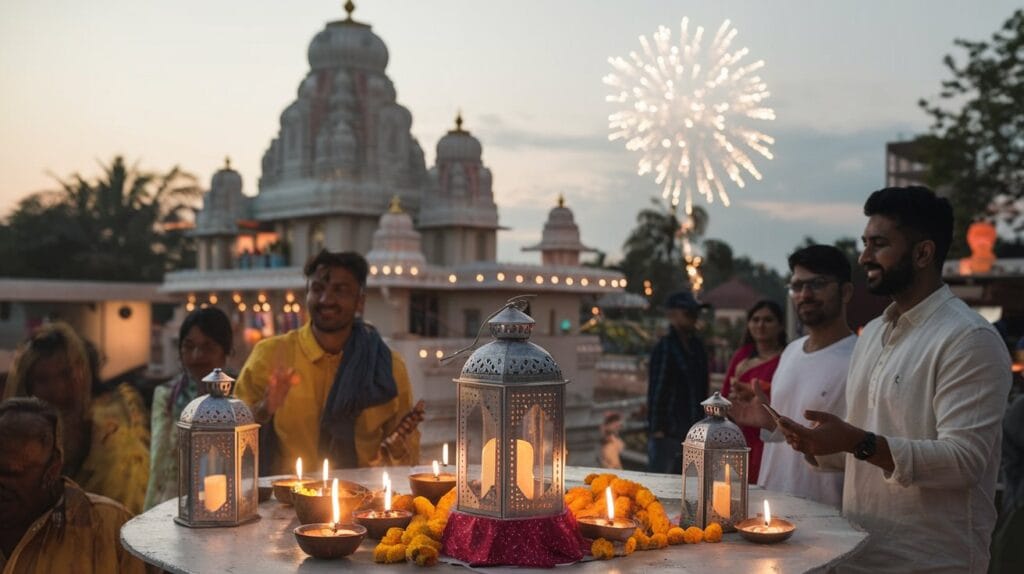
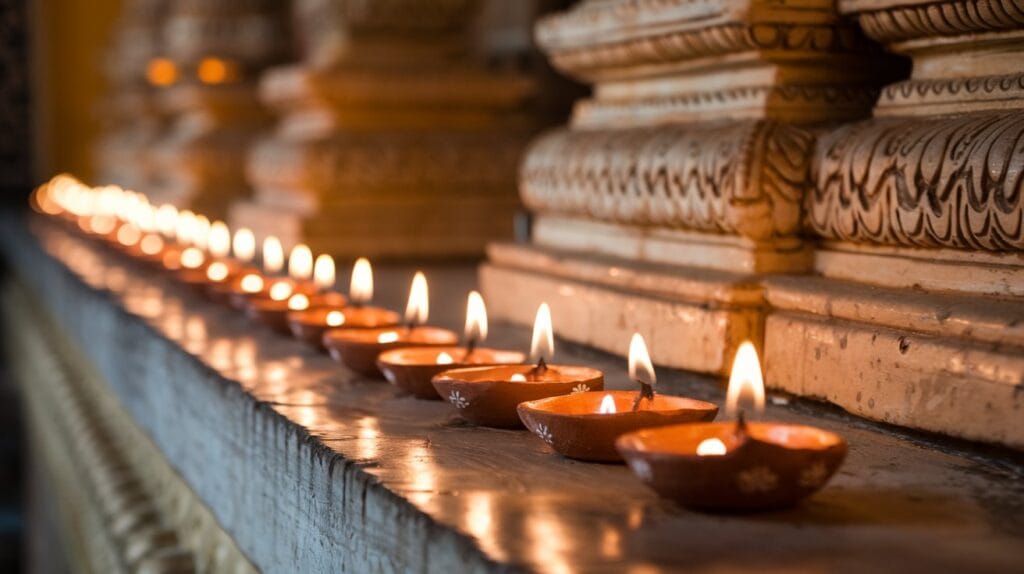

Holi: The Festival of Colors in Gujarat
Among the many Gujarati Festivals, Holi is one of the most colorful and exuberant celebrations, filling the air with laughter, joy, and vibrant hues. Celebrated in the month of Phalguna (usually March), Holi marks the arrival of spring and the victory of good over evil. In Gujarat, this festival is celebrated with unparalleled enthusiasm, bringing people together in a joyous explosion of colors, music, dance, and festivity.
Holi in Gujarat is a two-day affair, beginning with Holika Dahan, the ritual bonfire on the night before Holi. This is done to symbolize the burning away of evil, represented by the demoness Holika. Families and communities gather around the bonfire, sing devotional songs, and offer prayers, reflecting on the triumph of good over evil. The atmosphere is one of unity and spiritual renewal.
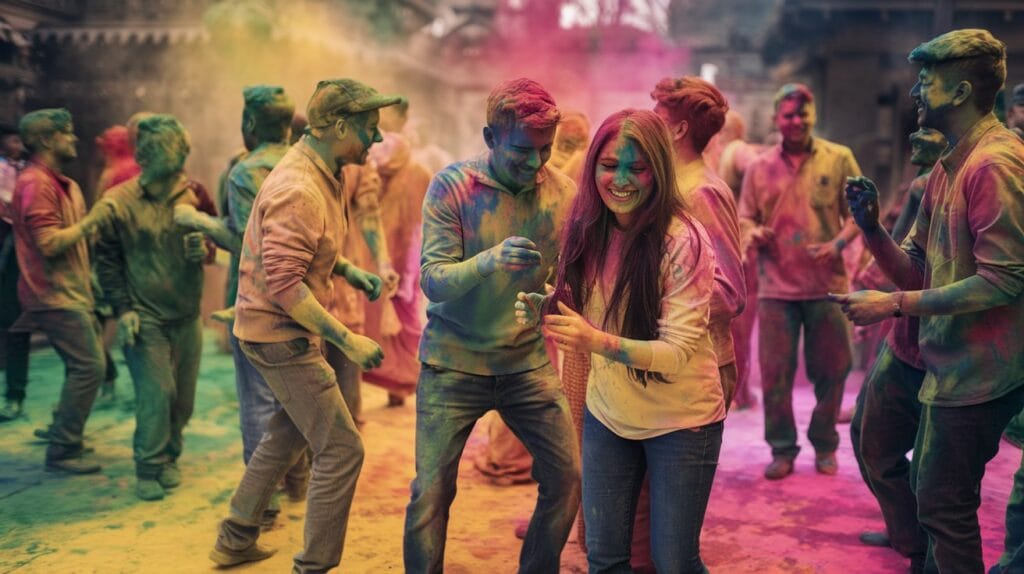
The next day, Gujarat witnesses the true spirit of Holi, as people of all ages step out into the streets to engage in Rang Panchami—the playful throwing of colored powders. The air is filled with laughter as friends, family, and even strangers smear each other with a rainbow of colors, turning the entire landscape into a kaleidoscope of joy. In cities like Ahmedabad, Surat, and Vadodara, the streets are lined with people dancing to lively music, spraying colored water, and exchanging sweets.
One of the unique aspects of Holi in Gujarat is the traditional Garba dances performed during the festivities. People dress in their best traditional attire and join in the energetic dances, adding a cultural flair to the already vibrant celebration. The festival is also marked by the preparation of special sweets, including gujiya and dahi puri, which are enjoyed by everyone during the celebrations.
Holi is not just about colors; it’s also about breaking social barriers. People of all backgrounds, castes, and communities come together to celebrate in harmony. The spirit of togetherness, unity, and joy that defines Gujarati Festivals is most evident during Holi, as it fosters a sense of belonging and creates bonds that go beyond family and friends.
For those who have never experienced Holi in Gujarat, it is an event that you’ll never forget. The colorful chaos, the infectious energy, and the warmth of the people make this one of the most delightful and heartwarming Gujarati Festivals. Whether you’re partaking in the color fights or enjoying the cultural festivities, Holi in Gujarat is an experience that celebrates life, love, and happiness.

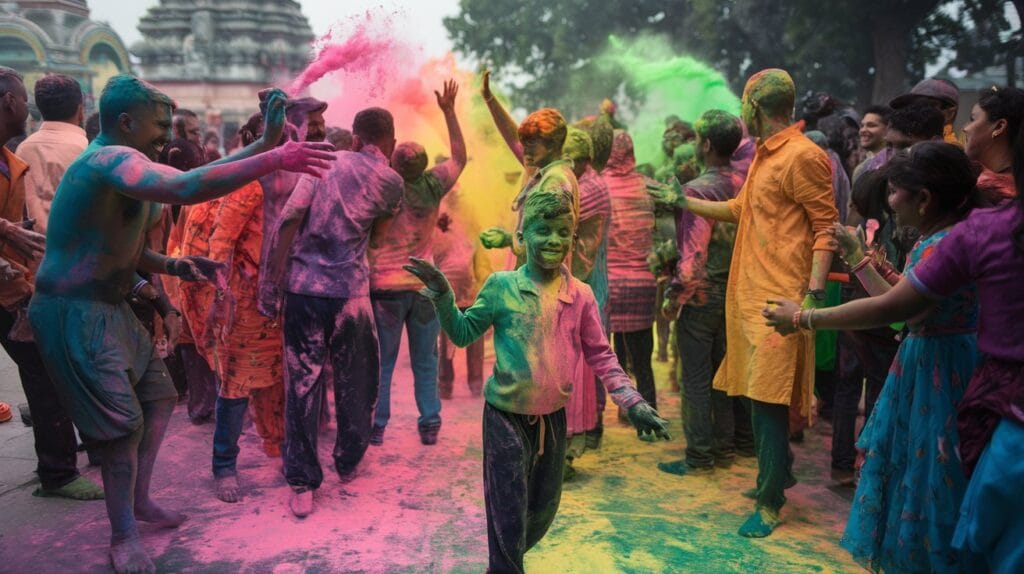

Significance of Festivals in Gujarat’s Culture
Gujarati Festivals are more than just celebrations—they are the very fabric that binds communities together, reflects the region’s rich heritage, and connects people to their traditions and spiritual roots. In Gujarat, festivals are a central part of daily life, offering a unique blend of religious devotion, social gatherings, and cultural expressions. The significance of these festivals goes far beyond rituals and ceremonies—they provide a sense of identity and pride, strengthening the bonds of family and community.
At the heart of Gujarati Festivals is the spiritual and religious connection to the divine. Many festivals in Gujarat are rooted in Hindu mythology, celebrating the lives of gods and goddesses, the triumph of good over evil, and the changing seasons. Diwali, Navratri, and Holi are prime examples where worship and joy are harmoniously intertwined. These festivals not only help individuals reconnect with their faith but also act as a reminder of the virtues and values that are central to the Gujarati way of life, such as hospitality, unity, and respect.
Festivals in Gujarat also serve as key moments for socializing and community-building. For instance, Navratri is famous for its traditional Garba and Dandiya dance, where entire villages and cities come together to celebrate with music, rhythm, and colorful attire. It’s a time when social barriers are broken, and people of all ages and backgrounds unite to enjoy the festivities. Similarly, Makar Sankranti, with its flying kites, and Vautha Mela, the cattle fair, are celebrations that not only highlight Gujarat’s agricultural roots but also emphasize the importance of community participation, family bonding, and rural life.
Moreover, Gujarati Festivals often mark significant agricultural events or seasonal changes, linking people to the earth and their livelihoods. These festivals are expressions of gratitude and reflection, as well as opportunities for renewal and reflection on life’s blessings. Whether it’s the harvest festival of Baisakhi, or the new year celebration of Bestu Varas, these festivals hold agricultural significance, acknowledging the connection between the people and the land they cultivate.
In addition to spiritual and social importance, Gujarati Festivals also play a crucial role in preserving the state’s rich cultural heritage. The performances of traditional music and dance, the preparation of region-specific sweets, and the crafting of local art and handicrafts during these festivals are all ways in which Gujarat’s diverse cultural identity is kept alive. Festivals give an opportunity for younger generations to learn about their roots, while also allowing them to actively participate in and contribute to these time-honored customs.
In conclusion, Gujarati Festivals are far more than simple occasions—they are deeply ingrained in the culture and identity of Gujarat. They provide spiritual fulfillment, foster community connections, celebrate traditions, and serve as a source of joy and belonging. These festivals not only reflect the region’s diverse cultural practices but also embody the spirit of Gujarat—vibrant, inclusive, and rooted in faith and tradition.
Conclusion: The Vibrant Spirit of Gujarat's Festivals
In conclusion, Gujarati Festivals are a reflection of the rich cultural heritage, spiritual depth, and joyous spirit of Gujarat. These festivals, each with its unique significance and traditions, showcase the colorful and diverse tapestry of life in the state. Whether it’s the lights of Diwali, the dance-filled nights of Navratri, or the community spirit of Makar Sankranti, these festivals bind the people of Gujarat together in a shared celebration of faith, culture, and tradition.
The vibrant spirit of Gujarati Festivals is seen not only in the celebrations themselves but in the unity they inspire among people of all ages and backgrounds. They are more than just rituals; they are moments of togetherness, where families reunite, communities come alive, and people reflect on the blessings of life. These festivals are a testament to the resilience, warmth, and inclusivity of Gujarat’s people, who, through their festivities, preserve and pass on their age-old customs and values.
The essence of Gujarati Festivals lies in their ability to create an atmosphere of joy, celebration, and harmony. They offer an opportunity for Gujaratis—whether living in the state or abroad—to stay connected with their roots, experience their culture, and share the beauty of their traditions with the world.
For anyone looking to experience the heart of Gujarat, its festivals are the gateway to understanding its rich culture and vibrant way of life. They are not just events on a calendar; they are celebrations of life itself, marked by joy, colors, music, and dance that resonate in the hearts of all who partake in them.
Ultimately, Gujarati Festivals are a living, breathing part of the state’s identity. They remind us that no matter where we are, the spirit of Gujarat lives on in its festivals—bright, bold, and full of life.
- All
- Eastern and Northeastern India
- GUJARATI
- Gujarat
- HOTELS
- Maharashtra
- Northern India
- Uttarakhand
- Visit in India
- Western India
- festivals


